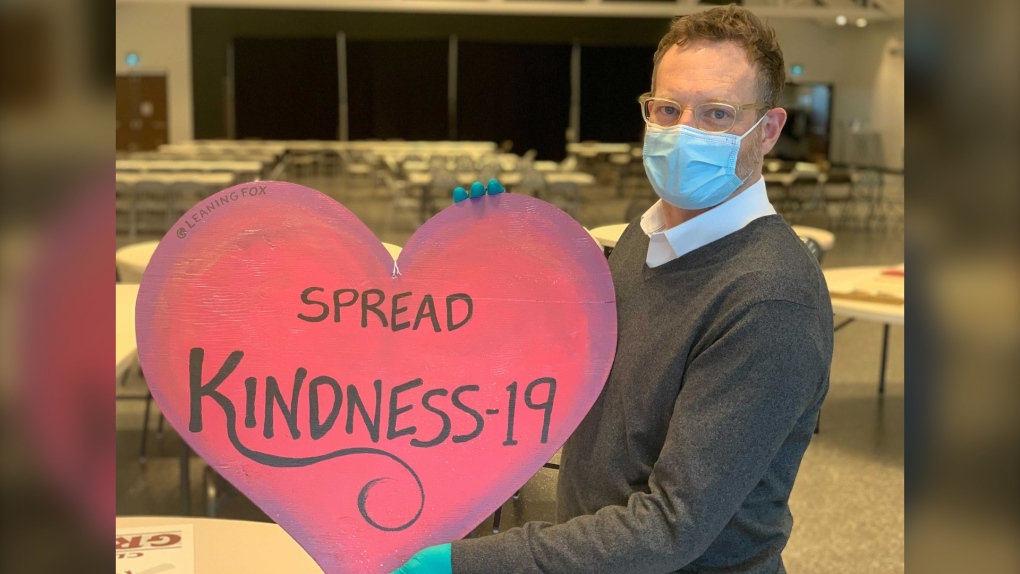'Very important for future generations': artifacts at Manitoba Museum to preserve pandemic history
A museum curator in Manitoba has been collecting artifacts of the pandemic so generations to come will remember when COVID-19 battered the province and changed the lives of countless Manitobans.
In early February, the Manitoba Museum put out a call for Manitobans to send in their pandemic-related artifacts.
"We need to build our collection now while it's fresh while the items are out there," said Roland Sawatzky, the curator of history at the Manitoba Museum in Winnipeg.
Items like face masks, personal protective equipment, and signs urging people to follow public health orders – all of which have become all too common for Manitobans in the past two years – will help preserve the history of the COVID-19 pandemic in the province.
These artifacts of the pandemic have been rolling in.
Sawatzky points to a gown made for a care home by a Hutterite community, a face shield made by two young men in their basement with a 3D printer, and a mask and head covering for medical staff made by two women in Winnipeg.
But along with the personal protective equipment, Sawatzky said the museum has received lots of art – such as a homemade sign used in a condo elevator encouraging people to wash their hands, or a sign in the shape of a heart saying, 'Spread Kindness-19' which had been put up at a testing site on Main Street.
 Roland Sawatzky, the curator of history at the Manitoba Museum, has been gathering artifacts to preserve the history of the COVID-19 pandemic in the province. (Source: Scott Andersson/ CTV News Winnipeg)
Roland Sawatzky, the curator of history at the Manitoba Museum, has been gathering artifacts to preserve the history of the COVID-19 pandemic in the province. (Source: Scott Andersson/ CTV News Winnipeg)
"You saw those in windows, you saw it on streets, in parks, it was kind of everywhere," he said, pointing to signs thanking frontline healthcare workers.
Sawatzky said he has received literature and poetry books that people had written during the pandemic.
He said after looking at all the artifacts he has noticed some key themes.
"One is how Winnipeggers came together in those first few months when there was not enough material to go around. You can see people coming together and working to make each other safe," he said.
"The creativity and the depth of the contemplation that Manitobans were doing at the time really comes through."
Sawatzky said these artifacts, while common now, will help people years from now understand what life was like in 2020 and beyond.
"(It's) very important for future generations," he said. "How are people going to know what humans in 2020 did, how did we react? And that includes the debates, and includes the isolation, it includes the emotions that are part of that – and this helps fill that story out."
-With files from CTV's Scott Andersson
CTVNews.ca Top Stories

BREAKING Donald Trump picks former U.S. congressman Pete Hoekstra as ambassador to Canada
U.S. president-elect Donald Trump has nominated former diplomat and U.S. congressman Pete Hoekstra to be the American ambassador to Canada.
Genetic evidence backs up COVID-19 origin theory that pandemic started in seafood market
A group of researchers say they have more evidence to suggest the COVID-19 pandemic started in a Chinese seafood market where it spread from infected animals to humans. The evidence is laid out in a recent study published in Cell, a scientific journal, nearly five years after the first known COVID-19 outbreak.
This is how much money you need to make to buy a house in Canada's largest cities
The average salary needed to buy a home keeps inching down in cities across Canada, according to the latest data.
'My two daughters were sleeping': London Ont. family in shock after their home riddled with gunfire
A London father and son they’re shocked and confused after their home was riddled with bullets while young children were sleeping inside.
Smuggler arrested with 300 tarantulas strapped to his body
Police in Peru have arrested a man caught trying to leave the country with 320 tarantulas, 110 centipedes and nine bullet ants strapped to his body.
Boissonnault out of cabinet to 'focus on clearing the allegations,' Trudeau announces
Prime Minister Justin Trudeau has announced embattled minister Randy Boissonnault is out of cabinet.
Baby dies after being reported missing in midtown Toronto: police
A four-month-old baby is dead after what Toronto police are calling a “suspicious incident” at a Toronto Community Housing building in the city’s midtown area on Wednesday afternoon.
Sask. woman who refused to provide breath sample did not break the law, court finds
A Saskatchewan woman who refused to provide a breath sample after being stopped by police in Regina did not break the law – as the officer's request was deemed not lawful given the circumstances.
Parole board reverses decision and will allow families of Paul Bernardo's victims to attend upcoming parole hearing in person
The families of the victims of Paul Bernardo will be allowed to attend the serial killer’s upcoming parole hearing in person, the Parole Board of Canada (PBC) says.


































